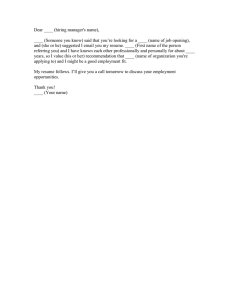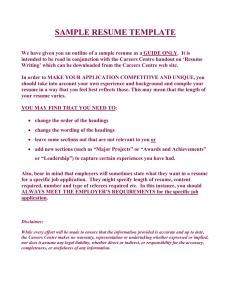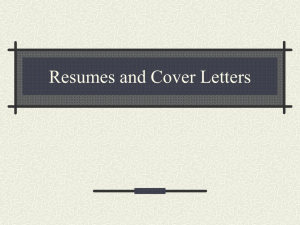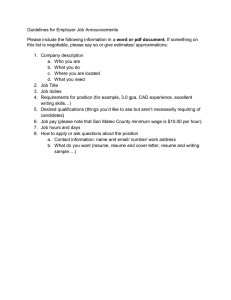Resume Writing - The University of Sydney
advertisement
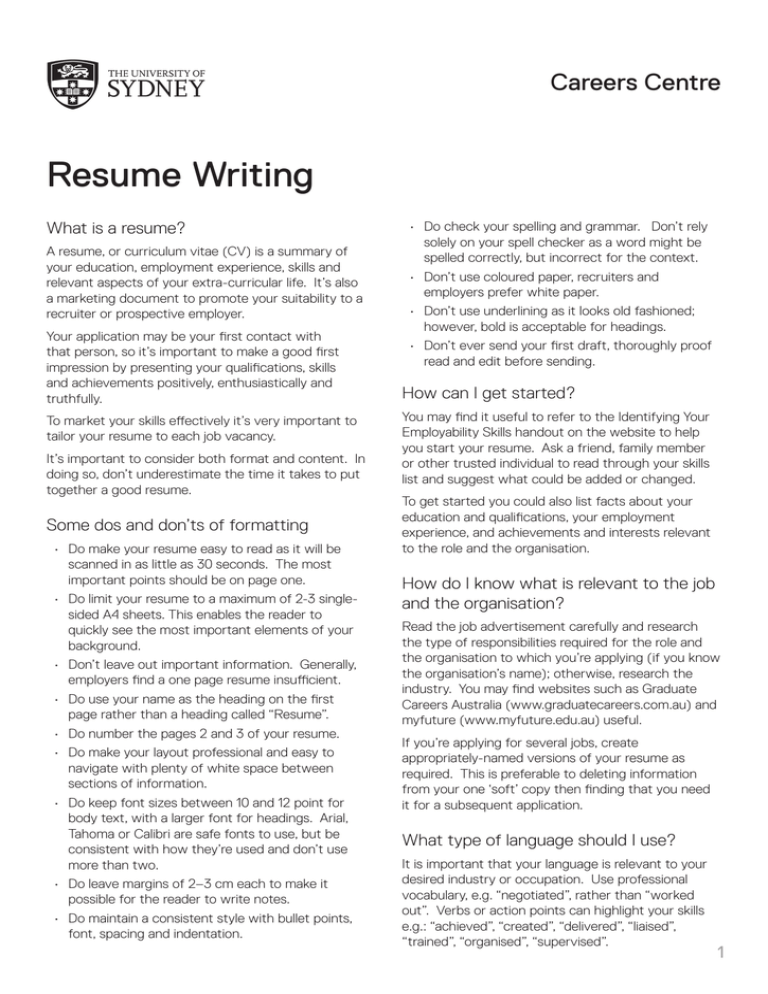
Careers Centre Resume Writing What is a resume? A resume, or curriculum vitae (CV) is a summary of your education, employment experience, skills and relevant aspects of your extra-curricular life. It’s also a marketing document to promote your suitability to a recruiter or prospective employer. Your application may be your first contact with that person, so it’s important to make a good first impression by presenting your qualifications, skills and achievements positively, enthusiastically and truthfully. To market your skills effectively it’s very important to tailor your resume to each job vacancy. It’s important to consider both format and content. In doing so, don’t underestimate the time it takes to put together a good resume. Some dos and don’ts of formatting • Do make your resume easy to read as it will be scanned in as little as 30 seconds. The most important points should be on page one. • Do limit your resume to a maximum of 2-3 singlesided A4 sheets. This enables the reader to quickly see the most important elements of your background. • Don’t leave out important information. Generally, employers find a one page resume insufficient. • Do use your name as the heading on the first page rather than a heading called “Resume”. • Do number the pages 2 and 3 of your resume. • Do make your layout professional and easy to navigate with plenty of white space between sections of information. • Do keep font sizes between 10 and 12 point for body text, with a larger font for headings. Arial, Tahoma or Calibri are safe fonts to use, but be consistent with how they’re used and don’t use more than two. • Do leave margins of 2–3 cm each to make it possible for the reader to write notes. • Do maintain a consistent style with bullet points, font, spacing and indentation. • Do check your spelling and grammar. Don’t rely solely on your spell checker as a word might be spelled correctly, but incorrect for the context. • Don’t use coloured paper, recruiters and employers prefer white paper. • Don’t use underlining as it looks old fashioned; however, bold is acceptable for headings. • Don’t ever send your first draft, thoroughly proof read and edit before sending. How can I get started? You may find it useful to refer to the Identifying Your Employability Skills handout on the website to help you start your resume. Ask a friend, family member or other trusted individual to read through your skills list and suggest what could be added or changed. To get started you could also list facts about your education and qualifications, your employment experience, and achievements and interests relevant to the role and the organisation. How do I know what is relevant to the job and the organisation? Read the job advertisement carefully and research the type of responsibilities required for the role and the organisation to which you’re applying (if you know the organisation’s name); otherwise, research the industry. You may find websites such as Graduate Careers Australia (www.graduatecareers.com.au) and myfuture (www.myfuture.edu.au) useful. If you’re applying for several jobs, create appropriately-named versions of your resume as required. This is preferable to deleting information from your one ‘soft’ copy then finding that you need it for a subsequent application. What type of language should I use? It is important that your language is relevant to your desired industry or occupation. Use professional vocabulary, e.g. “negotiated”, rather than “worked out”. Verbs or action points can highlight your skills e.g.: “achieved”, “created”, “delivered”, “liaised”, “trained”, “organised”, “supervised”. 1 In what order do I list the sections? backing up the claim with evidence e.g. It’s important to check that the information on your resume presents your best case in respect to the particular job. There is no ‘correct’ way to write a resume - choose the headings, content, layout and ordering that will best promote your skills and experience. The information below is intended for people with a tertiary education, seeking a position around the time of graduation. “Excellent Written Communication Skills - developed at university through activities ranging from writing complex technical reports during my science degree to preparing all publicity and press releases during my role as publicity officer for the University Biological Society.” Your Name Start the document with your name as the heading in large, bold lettering. Directly underneath, include the following: • address (and a vacation address if applicable) • contact phone number/s (ensure you have a clear and professional voicemail message) • one e-mail address (ensure it’s business-like). The following information is not required: • marital status, health and religion • date of birth • a personal photo Place of Birth Most jobs are for Australian citizens or residents. In order to dispel any doubt about your eligibility provide information about citizenship or pending permanent residency applications. Career objective A career objective describes the type and level of position you are seeking and the industry or area in which you would like to be employed. Employers have commented that a good career objective makes you look focused and enthusiastic. In order to promote your skills, include those that will contribute to the role and the organisation. Ensure that the objective is brief and realistic e.g. “A research position within Environmental Sciences where my university studies in water management and my work experience in local government in environmental management can be utilised.” Skills summary A skills summary on the first page provides the employer with a brief cluster of your key skills relevant to the position. Research suggests that the inclusion of a detailed skills summary or competency statement significantly improves the likelihood of gaining an interview. Each statement should take the form of a brief heading e.g. “Written Communication Skills”. To select the correct skills use the role’s selection criteria. Directly after the heading write 3-4 lines 2 Education - Tertiary Include: • the full name/s of the degree/s you’re studying or have studied. Don’t use abbreviations for a degree unless you’ve previously referred to it by its full name • the university/ies where you’re studying/have studied • major(s) • the year you’re currently in (e.g. second year) • averaged results • any academic awards or achievements If you’re applying to a graduate program you may be required to attach a copy of your academic transcript to your resume. Other optional inclusions are: • thesis topic/s • key subjects where you have gained specific and relevant skills or experience • major projects or areas of research You may be applying for a job where your degree is relevant only as evidence for your general level of education and intellect. In this case avoid including most course details and emphasise the more general and practical aspects of your qualifications. If your record includes unsatisfactory results, even failures, it’s not recommended to conceal them. Employers who are willing to look beyond academic grades will take into account your other attributes. Employers who are concerned with grades will be all the more disappointed when the truth is revealed. Your letter and/or your responses at interview should explain your record. Education - Secondary Include details of the final year of High School: • the level attained (e.g. Higher School Certificate) • the school you attended in your final year • your ATAR or UAI (or equivalent) result. Subjects studied are of interest only if relevant to the position or demonstrating something useful such as above-average achievement (e.g. 4 Unit Maths), or breadth of interest (e.g. Maths, Language, History). Other education and training Include relevant TAFE qualifications, certificates and community college courses. Training not associated with the job for which you’re applying can appear later. Practicums and industry experience For degrees such as Health Sciences or Education that require practicums or industry experience include the location of the practicum, length of time and relevant details e.g. which wards you worked on or which classes you taught. Include a summary of the skills and experience you gained. If you’re a final year Engineering student you need to include information on your industry experience. If you’ve had only one period of industry experience with one employer, include it in your Employment History rather than in a separate section. Employment history Start with your most recent job and work backwards. Include relevant part-time, casual and voluntary work with a position title, the name of the organisation and the suburb in which the organisation is (or was) located. Include tasks that aren’t evident from the job title e.g. if your job title was ‘Sales Assistant’ but your duties included training and supervising new staff, include that information. You can use bullet points; however, when writing about a job or an activity where you developed many valuable skills, include an extra line or two about your role. In order to give the reader an idea of your track record, make your employment history achievement oriented, rather than just a list of your responsibilities. Examples include: • the improvement of a procedure resulting in the saving of time and/or money • a promotion • an ‘Employee of the Month’ award, or compliments on your excellent customer service. For employment experience relevant to your chosen field, mention what you’ve gained from that employment in relation to the job you’re applying for. If you’ve had lots of similar types of part-time or casual jobs, summarise the information, e.g. ‘worked as a waiter in a number of restaurants.’ You can also include a summary of the skills gained from those positions including the dates worked (month and year are sufficient). Include volunteer work in this section. This is particularly the case where the voluntary work is related to the area in which you wish to gain employment. Where the volunteer work isn’t related to your study and not something that you’ve done with any consistency (e.g. a fundraising activity), include it in your resume; however, put it in the section on ‘Extra-curricular Activities’. Other skills and attributes You may include details of computer skills or language skills. For example: • Competence in the Microsoft Office suite • Fluency in written and spoken English, Mandarin, Modern Greek, Vietnamese Extra-curricular activities These may be in educational, community and church activities; in sport or the arts; both on or off campus. If you’ve been involved in few extra-curricular activities, list each activity as a bullet point. You may have been involved in a significant activity such as the organisation of a major social or sporting event. If so, include details of the skills you used and the contribution you made, for example: Organiser of graduation ball • designed and distributed themed invitations • coordinated caterers, menus and music • through a promotional drive, increased attendance at the Ball by 10% on previous year If you’ve been involved in lots of activities, use subheadings to group activity types e.g. positions of responsibility or representative positions, personal achievements, and/or memberships. Following are examples of subheadings and relevant activities: Positions of responsibility held: • Secretary-Treasurer, Economics Students Society • Scout Leader Manly-Warringah 2009 onwards Memberships: • Chartered Accountants Society • Alliance Francaise Personal Achievements: • Senior Duke of Edinburgh Award • Member of University Debating Team • Rotary Exchange Student (Holland) Interests Employers are interested in finding out about your interests and the skills developed from those activities, as these might be useful in the workplace. Be genuine about your list as you may be asked to talk about your interests at interview. Interests say a lot about you, so make sure those you list are appropriate and that they indicate you are a well-rounded person. List only the interests that you want the employer to know. 3 Referees employer. When employers are trying to decide whether or not to employ you, they often find it helpful to talk to people who know about you and your work - how you fit in with your colleagues, tackle problems, or whether you complete assigned tasks. Referees are the people you ask to do this for you. What about written references? If you are asked for names of three referees give three names, not four names or three written references. If including names of referees on your resume, include: the person’s name; their position title; the name of their organisation/employer; their contact phone number/s and their e-mail address. Ensure that you ask a person’s permission before including their name as a referee. If you don’t wish to list names of referees on your resume, under the heading ‘Referees’ type ‘Available on request’. It’s important to provide a separate list of referees at an interview. If you’ve been asked to include your referees list on your resume, make sure that you do so. How many do I need and who should I ask to be a referee? Usually two referees are sufficient. One should be someone with knowledge of your academic skills. Think about which academic staff member you’ve had the most contact with and approach that person. Your other referee may be a present or past employer who can talk about on-the-job skills you’ve demonstrated and the way you’ve handled yourself with customers and colleagues. Another type of reference is a ‘character’ reference from someone such as a family friend who’s known you for a long time. It’s preferable to choose someone who holds a position of responsibility or high regard in the community. If a referee has moved or is no longer working for the same organisation, that person is still eligible to be your referee if you can locate him or her. Important information for referees Give your referees information about the type of job you’re applying for by providing a copy of your resume and if you can, a copy of the job description. Having this documentation makes it easier for referees to speak positively and knowledgeably about you. It’s also important to keep your referees informed about when they might be contacted by a recruiter or The University of Sydney Careers Centre Level 5, Jane Foss Russell Building (G02), 160 City Road, Darlington NSW 2006 CRICOS Provider No. 00026A There are two types of references - a confidential reference and a non-confidential reference. The former is a confidential statement written by a referee about you and your ability to do the job for which you’ve applied. This type of reference is more commonly required for public sector positions where the referee is asked for information specifically related to the job’s selection criteria. The non-confidential reference is the ‘to whom it may concern’ document commonly obtained from an employer at the end of service or from a school principal or university teacher. Some final dos and don’ts Don’t take your skills for granted by leaving out important information. Remember that the tasks you consider to be ‘just something I do as part of my job’ can require highly-marketable skills, e.g. customer service, communication, teamwork, leadership and time management skills. • Do consider the importance of transferable skills. Although employment in your chosen field is very valuable, it’s also possible to acquire relevant skills from seemingly unrelated part-time jobs. Don’t omit these jobs from your resume because you think they’re not important. • Don’t put your resume in a folder or binder unless you’ve been asked to do so. Use a small bulldog clip or a paper clip to attach your documents and send it to the employer in an A4 envelope. For information on e-mailed and online applications see the handout on Job Applications. What if I need more help? If you’d like further assistance with your resume we suggest you work through Module 4 of Resume Express, an online tutorial program on the Careers Centre’s website. You can also register for a Resume Rescue workshop. Avoid the following errors we often see on resumes: • Gaps in the employment history. If you’ve been travelling for a year, say so. • Insufficient details about job responsibilities and achievements. This means that your skills and experience are not effectively promoted. • Failure to pick up errors in spelling and grammar. Check your work thoroughly before submitting it. Sample resumes can be viewed at the Careers Resource Centre. T: +61 2 8627 8403 | F: +61 2 8627 8477 E: careers.information@sydney.edu.au sydney.edu.au/careers 4
